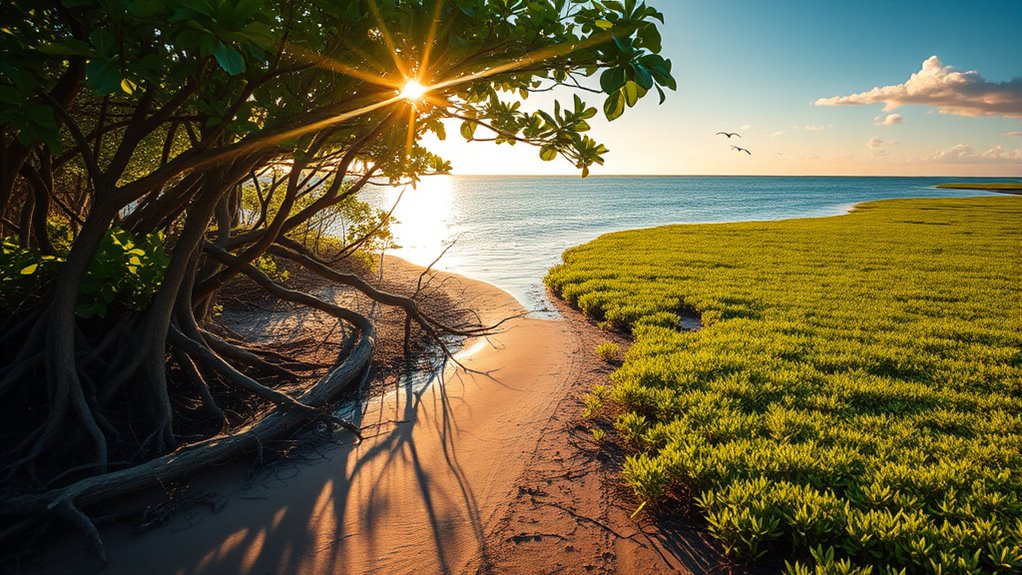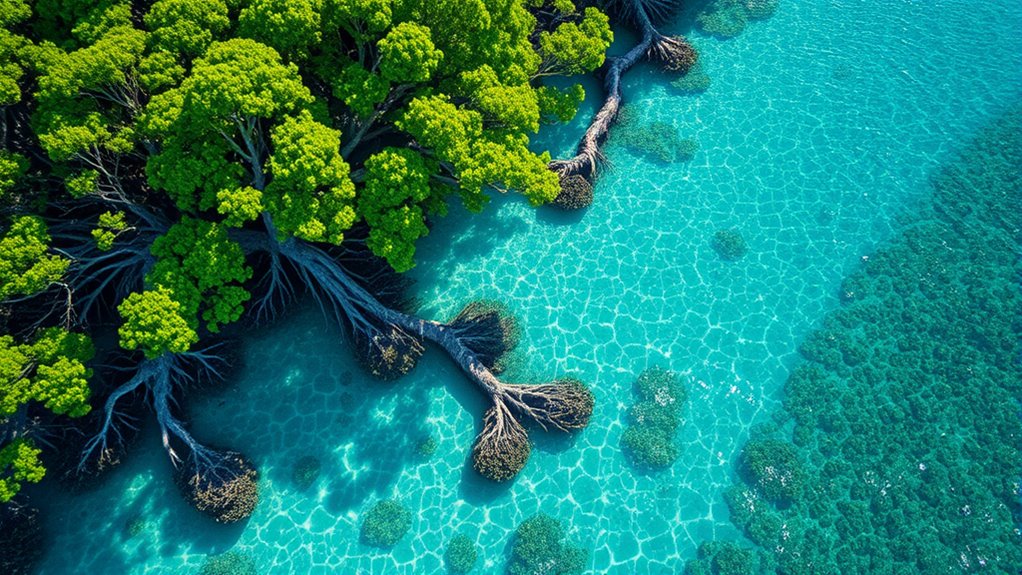Coastal ecosystems like mangroves, salt marshes, and seagrasses play a crucial role in capturing and storing carbon, making them powerful natural allies against climate change. These habitats act as blue carbon sinks, sequestering large amounts of CO₂ in their soils and biomass, often more efficiently than terrestrial forests. Protecting and restoring these ecosystems helps stabilize our climate and boosts biodiversity. If you want to discover how these essential habitats can help combat climate change, keep exploring further.
Key Takeaways
- Coastal ecosystems like mangroves, salt marshes, and seagrasses act as vital blue carbon sinks, capturing and storing atmospheric CO₂.
- Protecting and restoring these habitats enhances their carbon sequestration capacity, aiding in climate change mitigation.
- Mangroves store more carbon per hectare than many terrestrial forests, making their conservation essential for climate stability.
- Seagrass beds sequester carbon in sediments for centuries, providing long-term climate regulation benefits.
- Conserving blue carbon ecosystems supports biodiversity, resilience against climate impacts, and overall ecosystem health.

Coastal ecosystems, such as mangroves, salt marshes, and coral reefs, play a pivotal role in regulating the Earth’s climate. They act as natural carbon sinks, capturing and storing vast amounts of carbon dioxide from the atmosphere. By doing so, they help mitigate the impacts of climate change and maintain global temperature balance. Protecting these ecosystems is essential, and mangrove protection is a key part of this effort. Mangroves, with their dense roots and unique structure, store more carbon per hectare than many terrestrial forests. Preserving existing mangroves prevents the release of stored carbon and guarantees the continued sequestration of new carbon. Additionally, restoring degraded mangrove areas can markedly boost carbon storage capacity. When you support mangrove protection initiatives, you’re actively contributing to climate change mitigation and safeguarding biodiversity.
Seagrass restoration is another fundamental strategy for enhancing blue carbon stocks. Seagrasses thrive in shallow coastal waters and are among the most efficient carbon sinks on the planet. They sequester carbon both in their biomass and, more importantly, in the sediment beneath them, which can store carbon for centuries. Restoring seagrass beds not only increases carbon sequestration but also improves water quality, stabilizes sediments, and provides habitat for marine life. Protecting and restoring these habitats also supports biodiversity conservation, which is vital for resilient ecosystems. If you’re involved in seagrass restoration projects, you’re helping to rebuild essential ecosystems that have been declining due to coastal development, pollution, and warming seas. These efforts directly contribute to climate regulation and resilience.
Frequently Asked Questions
How Do Blue Carbon Ecosystems Compare to Terrestrial Forests in Carbon Storage?
You’ll find that blue carbon ecosystems, like mangroves and salt marshes, often store more carbon per hectare than terrestrial forests. Oceanic sequestration in these coastal areas is highly efficient, and their ecosystem resilience helps maintain long-term carbon storage. While terrestrial forests are essential, blue carbon ecosystems provide unique benefits by protecting coastlines and enhancing climate regulation, making them critical in combating climate change.
What Are the Main Threats to Coastal Ecosystems’ Blue Carbon Capacity?
You should know that over 50% of blue carbon is stored in just 15% of coastal ecosystems, highlighting their importance. Pollution impacts, like oil spills and plastic waste, damage these essential habitats, reducing their carbon storage ability. Coastal development, including urbanization and infrastructure projects, leads to habitat loss and degradation, further threatening blue carbon capacity. Protecting these ecosystems is imperative for maintaining their role in climate regulation.
Can Blue Carbon Ecosystems Recover After Significant Damage?
Yes, blue carbon ecosystems can recover after substantial damage if you focus on enhancing ecosystem resilience through effective restoration techniques. By actively restoring mangroves, salt marshes, and seagrasses, you help rebuild their ability to sequester carbon and support biodiversity. Restoration techniques like replanting, hydrological management, and controlling invasive species are essential. Your efforts can markedly improve the health and carbon storage capacity of these critical coastal ecosystems.
How Does Climate Change Affect Blue Carbon Sequestration Rates?
Climate change reduces blue carbon sequestration rates by up to 20% by disrupting coastal ecosystems. You might notice ocean acidification weakening shell-forming organisms, while sea level rise floods mangroves and salt marshes. These changes hinder plants’ ability to absorb and store carbon effectively. As a result, the crucial role of blue carbon ecosystems in combating climate change diminishes, making it essential to address these impacts now.
What Policies Best Support the Conservation of Blue Carbon Habitats?
You should support policies that establish Marine Protected Areas to safeguard blue carbon habitats, ensuring their preservation and resilience. Advocate for policy incentives like grants, tax breaks, or funding for restoration projects that encourage local communities and stakeholders to conserve these ecosystems. By promoting these measures, you’ll help maintain the essential carbon sequestration functions of coastal ecosystems and combat climate change effectively.
Conclusion
As you consider the crucial role of coastal ecosystems, it becomes clear that their gentle nurturing helps us navigate a more balanced climate future. By protecting these delicate habitats, you softly support the Earth’s natural rhythms, ensuring they continue to absorb and store carbon gracefully. Ignoring their quiet contributions could mean missing a subtle yet powerful opportunity to stabilize our climate. Embracing their preservation isn’t just wise—it’s a gentle call to safeguard our shared tomorrow.










